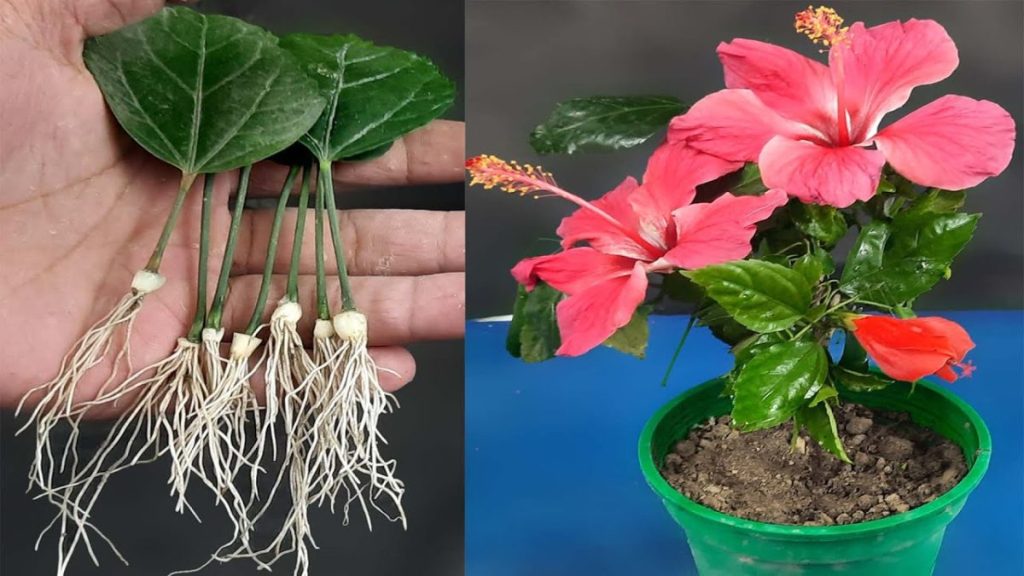Hibiscus syriacus is an ornamental plant commonly called in Italy by the name of Hibiscus.

Discover a groundbreaking and incredibly simple method to propagate Hibiscus syriacus, an ornamental gem that graces many gardens with its vibrant presence. Known in Italy simply as Hibiscus, this member of the Malvaceae family boasts over 400 species that adorn landscapes across Europe, Oceania, America, Asia, and Africa.
Fear not, for cultivating hibiscus through leaf propagation is neither a Herculean task nor a meticulous science. With a touch of care and gentleness, you can easily start this process. Let’s dive into how you can grow new hibiscus plants from leaves alone!
Simple Steps to Grow Hibiscus from Leaves
1. Preparing the Leaves: Start by gently removing healthy-looking leaves from the hibiscus stem. Choose as many as you like, but ensure they appear vigorous and disease-free.
2. Setting Up Your Propagation Station: Take a plastic bowl and make a small hole in the center at its base. Place this bowl on a flat plate. Fill the bowl with sand to the top and add enough water so that the sand is completely submerged. Wait until the water has been absorbed and some is sitting in the plate below.
3. Arranging the Leaves: Carefully place the leaves around the perimeter of the bowl, leaving the center empty. This arrangement allows each leaf ample space to breathe and grow.
4. The Waiting Game: After 25 days, add just a drop of water to the bowl. Then, gently remove the leaves. You’ll be greeted by the sight of newly formed roots – a true marvel of nature!
5. Preparing for Planting: Wash away any excess sand from the roots by lightly pouring water over them. Fill a flowerpot with garden soil, readying it for the next step.
6. Planting Your Hibiscus Leaf: Plant a single leaf in the prepared soil and water it. Repeat the process with the remaining leaves if desired.
7. Watching New Life Emerge: Within 30 days, keep an eye on the soil where you’ll witness the emergence of new hibiscus leaves, signifying the start of a new plant.
This innovative leaf propagation method not only simplifies the process of growing Hibiscus syriacus but also opens up a new world of gardening possibilities. Whether you’re a seasoned gardener or a curious novice, this technique promises a rewarding and delightful experience as you watch new life unfold from a single leaf. Embrace this method and add a flourish of beauty and diversity to your garden with new hibiscus plants.
This plant, which belongs to the Malvacce family, includes 400 different species which are widespread above all in Europe, Oceania, America, Asia and Africa.
Below we will go to see how to grow these plants by directly burying its leaves.
Don’t be scared, caring for and growing hibiscus is not an extremely difficult job. The most important thing to successfully complete this operation is to be careful and delicate.
Let’s get started now!
How to reproduce the Hibiscus from its leaves – New very simple method!
The first thing to do is to remove the leaves from the stem of the plant.
After having taken the quantity of leaves that we deem appropriate, and which appear healthy, we place a plastic bowl on a flat plate. Please note: first you need to create a small hole in the center of the base of the bowl.
Next we fill the bowl with sand. We pour the sand up to the brim and then add some water. The water must exceed the level of the sand so as to cover it completely.
When the water appears absorbed by the sand, and we see some of it floating in the plate below, we will be able to neatly arrange the leaves inside. The important thing is to distribute the leaves along the entire perimeter of the bowl, taking care to leave the center empty.
After 25 days we pour a drop of water into our bowl and then gently extract the leaves. Once they have all been recovered we will be able to admire the spontaneously born roots.
We then remove the excess sand by pouring a little water over it.
At this point we fill a flowerpot with garden soil.
Finally we plant only one leaf in the ground and water it with water. Obviously we can repeat the same process for the other remaining leaves.
After 30 days we will be able to admire the birth of some new leaves in the ground.



